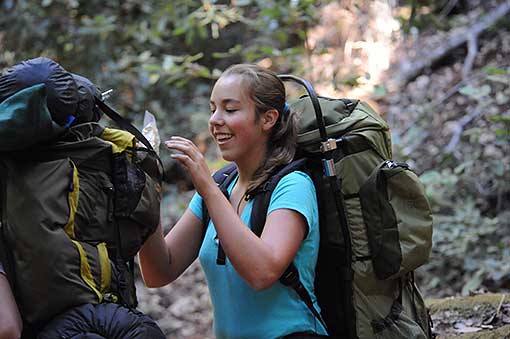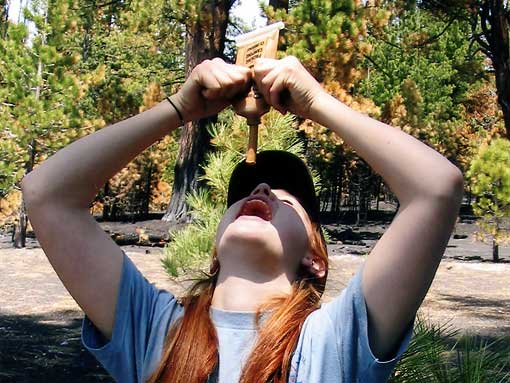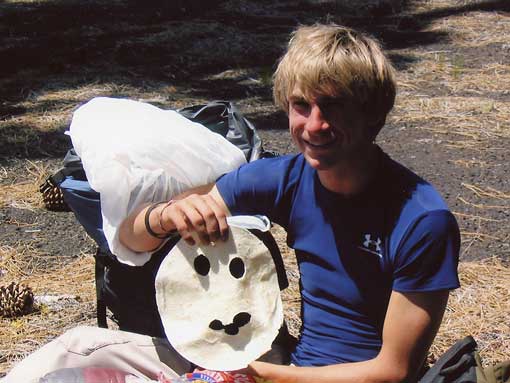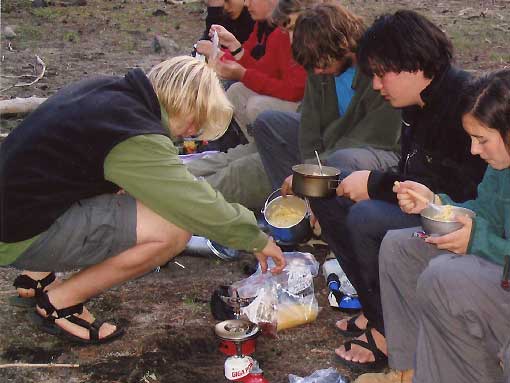Backpacking Food Primer
Lassen National Park 2005
David Frydenlund, October 2008
This primer is written with Scout outings in mind where the hiker may be any age from 11 years old up. The idea is to provide fundamental information which will allow people new to light weight travel to plan successful meals and to allow experienced people to see some alternatives to the way they have always done it. As with most things that I write, this is intended to be a guide to first principles from which people can make creative choices.

Assumptions
Assumption Number 1. KISS. Keep It Simple Stupid. When backpacking, food is a means to an end, not an end in itself. It is possible to eat extremely well while camping but elaborate food preparation should be reserved for car or canoe camping.
Assumption Number 2. Fully balanced meals are not essential. No one ever suffered much from omitting one or more basic food groups over a three day period so long as there are both sufficient calories and sufficient hydration.
Assumption Number 3. It should not be boring. There should be variety. It should be flavorful and have a pleasing texture. I have backpacked with people who lived on energy bars and water for 50 miles. Others have lived off nothing but noodles or peanut butter mixed with powdered milk. Not for me…
Assumption Number 4. Utensils should be kept to a minimum. It is possible to eat quite well while carrying only a pot to boil water in, a cup for measuring and drinking, and a spoon or spork (spoon/fork combination).
Assumption Number 5. In keeping with Assumption 1 above, the cooked meals will generally start with “boil water”. Once the water is boiling there should be no need for further heating.This conserves fuel, reduces the level of operator attention required and eliminates the possibility of burned food.
Assumption Number 6. If you do not like it at home, you probably will not like it in the back country. If it is hard to prepare at home, it will be harder in the field. Smart campers test the things they are going to do on a trip at home where the consequence of mistakes is cooking a different meal. In the back country the consequence is having to eat your mistakes, something which can be quite unpleasant.
Assumption Number 7. It should not break the bank. Back pack food can be extremely expensive or quite cheap depending on the choices you make. In my experience there is little correlation between the amount you pay and your satisfaction in the field.
Assumption Number 8. It should be light. By this I mean there should be a high density of calories per gram of food carried. Meats and nuts are two foods that tend to be packed with calories. Chocolate is also pretty dense. Whether or not dehydrated is important is a function of whether or not water is freely available. If water is scarce, it makes no difference whether you carry the water in the food or in a separate container.Often packaging adds a great deal to the weight. Repackaging can save as much as half the weight.
Assumption Number 9. Quantities are situational. Cold weather requires more calories than hot weather. Climbing requires more calories than level walking. Big people generally require more calories than little people. Individual metabolisms vary. On average, an idle adult needs about 1200 calories per day. A cross country skier can consume more than 5000 calories per day. For typical Scouting activities it makes sense to target a minimum of 2000 calories per day. More is better than less, except the more you plan, the more you carry. The ideal is to carry exactly what you need, no more, no less. While I am quite comfortable with carrying slightly too little and being a little bit hungry, most of my backpacking companions have preferred carrying a little too much and never being hungry. The longer the trip, the more critical it is to balance calories in to calories out. For a weekend trip it is not a big deal.Most people could do a whole weekend backpack with little or no food and be OK (but not very happy). For a week long trip too many calories can break your back and too few can break your spirit. Both are dangerous.
Approaches
Approach Number 1
Do the obvious. Buy packaged meals designed for back packing or military applications. Prepare in accordance with the instructions and eat. The drawbacks to this approach include fixed portion size, expense, potentially high sodium content, significant questions of taste and texture, and limited selection of foods.
The simplest is to buy MREs (Meals Ready to Eat). These are complete meal packs and do not require the addition of water. They can be eaten hot or cold. They are “no skill” meals. The typical cost is $6 – 10 per person per meal. They can be purchased from military surplus stores, survivalist food outlets, and specialty outdoor equipment stores (such as REI and Redwood Trading Post).
Next simplest is to buy food in pouches from brands like Mountain House. The pouches come in serving sizes intended for one, two, or four people depending on the product. Most of these offerings are precooked, freeze dried. Once re-hydrated they can be eaten hot (as most are intended) or cold. There is considerable variety available. Field experience has shown that some of the offerings are considerably less satisfying in taste and/or texture than others. These should definitely be sampled at home before being used in the field. Many folks settle in on five or six kinds that they find they like and use only those. The cost for a single serving pouch tends to run in the $5 – 7 range. Serving pouches for two go for $6 – 9 and serving pouches for four go for $9 – 13. One should NOT assume that a four serving pouch is a complete meal for four people. Nor should one assume that what is in a pouch is a complete meal. They can be purchased from military surplus stores, survivalist food outlets, and specialty outdoor equipment stores.
Many people are not aware that many of these dehydrated meals are also available in #10 cans packed as survival foods with a 30 year shelf life. A #10 can is typically designed to feed 8 to 10 people. The food can be re-hydrated in the can for an entire group or it can be broken out into smaller servings and re-hydrated in freezer bags as described in more detail in Approach 3 below. Depending on the nature of the food (especially the type of meat, if any) a can might go from around $25 – 65. These are easiest to find on the internet at places like: http://www.thereadystore.com
Approach Number 2.
Take advantage of packaged foods that are readily available at stores which can be put together to form meals. Re-package as necessary to reduce weight and bulk. If you walk through a large grocery store and are specifically looking for foods which are individually packaged and suitable for back packing you will find that there are many available choices. Some of them even come in foil packs which make it possible to cook them in their original packaging.
The words instant or quick are often useful clues to things which can be cooked using just boiling water. It should be useful to go through some examples, meal by meal.

Useful Examples
Breakfast: Oatmeal, Grits, Hominy, and Maltomeal all come in quick or instant forms and all come in individual serving packets as well as in larger containers. Add a little dried fruit like raisins and some nuts and you have a special treat. Throw in a little Tang (hot or cold) or some other favorite powdered drink mix and you have a complete breakfast. If it is cool or cold, some hot chocolate or hot cider really hits the spot. Some skip all that and substitute pastry for the cereal. Some folks carry granola and eat it dry or soaked in Tang for breakfast.
Lunch: Some folks in some seasons like a hot lunch. For them there are products like “Cup of Noodles” (which come with their own styrofoam cup), “Cup of Soup”, and other powdered soups. There are also snack pack lunches which do not require refrigeration like tuna and crackers, ham and crackers, and cheese or peanut butter and crackers. Some folks also carry cheese in a can (ex: Easy Cheese) and crackers to spray it on. Hard sausage (non-refrigerator) and hard cheese with bread, rolls or crackers are also possibilities. Non-crushable breads are a good choice and many experienced back packers carry mostly pita and tortillas. Peanut butter and jelly or honey on a rolled tortilla makes a really fine lunch. Some folks put tuna (with or without mayo) in their pita or tortilla. Some folks eat the tuna right out of the foil pack and think that is a great lunch. Lots of people supplement or finish with fresh or dried fruit.
Dinner: Dinners typically combine some sort of starch (potatoes, rice, pasta) with some sort of protein (meat, fish, eggs, soy, nuts). Some ideas about combinations that work can be found on in our Backpacking Food Quick Guide. Generally, prepackaged proteins are found in both pouches and cans. Readily available choices include salmon, tuna, albacore, crab, chicken, turkey, pork (ham, Spam), soy, and nuts. Prepackaged starches include a broad range of choices of pasta and rice sides from Knorr (formerly Liptons), Idahoan Potatoes, and various ramen noodle based dishes. A wide variety of meals can be made by adding boiling water directly to the pouch of the chosen starch and, after ten minutes or so of hydration and cooking, adding the chosen protein and then eating. Vegetables are often things like baby carrots or celery. Often raw or dried fruits are substituted for vegetables. These include raisins, craisins, apricots, apples, bananas, pineapple, etc.
Drinks: Drinks are typically powdered. For cold drinks the most common are lemonade, tea, tang, fruit flavored drinks.For hot drinks the most common are tea, hot chocolate, hot cider, and flavored gelatin (JELLO) drunk hot.
Snacks and Desserts: Trail Mix, Glop, Granola Bars, Energy Bars, Nuts, Cookies, Brownies, Fudge, and Candies are all popular.Some back packers have food readily available and graze nearly continuously while they hike.
Approach Number 3
We build on Approach Number 2, but give ourselves even more flexibility by not limiting ourselves to pre-built meals. In this approach we use freezer zip lock bags to cook in and we build our meals out of a broader mix of ingredients. Details about how to do this can be found at: www.trailcooking.com. The general approach is to combine a set of ingredients in a quart or gallon size freezer bag which will cook together when boiling water is added and the mix of water and ingredients are allowed to sit in a “cozy” for ten minutes. There are literally hundreds of recipes available. Here I will give a list of some of the basic ingredients that recipes can be invented from.
Note that all the products in Approach 2 are also useful in this approach. Note also that dried vegetables can sometimes be found in bulk in regular or specialty grocery stores and can also be found in cans and pouches at military surplus stores, survivalist food outlets, and specialty outdoor equipment stores. They are also available from companies like Harmony House, Mountain House and Saratoga Farms through internet outlets like: http://www.thereadystore.com Oriental food stores are also an outstanding source of things like bean threads, ramen, dried vegetables, and dried mushrooms. Dried vegetables can sometimes also be found in the baby food section.

Useful Foods
Useful starch bases for meals:
Knorr (Liptons) Sides (Rice or Pasta, less than ten minute cook), Stove Top Stuffing, Instant Rice (white or brown), Bean Threads, Fine Egg Noodles, Ramen, Instant Potatoes, Idahoan Potato Pouches, Couscous, Instant Refried Beans, Instant Hummus, Oatmeal, Grits, Hominy
Useful Proteins:
Precooked Bacon (whole or shredded), Soy Meat Substitutes, Tuna, Albacore, Salmon, Crab, Ham, Spam, Turkey, Chicken, Hard Sausage, Nuts, Dried or Fresh Eggs, TVP (Textured Vegetable Protein), Hard or Dry Sausage, Jerky (Beef, Chicken, Turkey, Snake, etc.) [Note Commercial Pre-cooked Ground Beef is generally awful. Some folks prepare their own by browning, dehydrating and vacuum packing]
Useful Flavorings:
Flavor Packets from Couscous and Ramen, Instant Onion, Cheese Sauce Powder, Soup Starters, Dried Tomatoes, Spice Packets, Gravy Packets, Boullion, Cheese, Cheese Powder Sauce, Butter Flavored Powder, Dried Milk, Dried Soy Milk, Coconut Cream Powder, Honey, Sugar (white and brown), Olive Oil
Useful Vegetables:
Baby Carrots, Celery, Vegetable Soups and Starters, Dried: Tomatoes, Mushrooms, Peas, Green Beans, Cauliflower, Corn, Celery, Bell Peppers, Mixed Vegetables, Onions, Refried Beans, Carrots
Useful Fruits:
Dried: Raisins, Craisins (Dried Cranberries), Cherries, Apricots, Apples, Bananas, Pineapple, Mangos, Papaya, Dates, Figs, Strawberries, Raspberries, Blueberries, Coconut, Pears, Peaches, Prunes (or Dried Plums), Cantaloupe, Mixed
So, how do I use this?
Let us throw together a quick, but unusual, breakfast. In a quart sized freezer bag I combine a cup of couscous, a handful of raisins, some pecans, and a couple of teaspoons of brown sugar (more or less to taste). To cook breakfast (for 2?) I boil 2 cups of water, add it to the contents of the freezer bag, squish it around, put it in a cozy for ten minutes and then eat.While it is in the cozy I can mix up some Tang or boil another round of water and have some hot chocolate.I could substitute rice, oatmeal, grits or hominy for the couscous. I could substitute any dried fruit (or a mix) for the raisins.I could substitute walnuts for the pecans (or leave the nuts out completely). I could add milk powder to make it creamier. I could substitute lemonade or tea for the Tang.
Let us throw together a “Thanksgiving” dinner for the last night out. I start with 1 ½ cups of stuffing. Throw in a handful of craisins.In a second bag, throw in a packet of gravy mix. Carry along a 7 oz packet of chicken or turkey, and a teaspoon of olive oil. Boil 2 ½ cups of water. Put half the water with the stuffing and half with the combined chicken and gravy.Ten minutes in the cozy and mix together. I could add peas or corn to the stuffing and craisins. I could make them separately. I could substitute turkey for chicken.Easy dinner for two.
Or let us make a super simple Ramen meal. In a bag we place one block of Ramen (with or without the attached spice bag contents). We boil 1½ cups of water and add it to the bag.Let sit for ten minutes. To this basic starch we could add: bacon, bacon bits (soy), chicken, turkey, ham, shrimp, or tuna, etc. as a protein. We could then add dried vegetables. We could also add flavoring using: spices, cheese or cheese powder, dried tomato, BBQ sauce, olive oil, or ranch dressing.If I did not want Ramen, I could substitute couscous, fine egg noodles or instant potatoes.
Obviously not all the items blend with all the other items in the list above. But, with a little imagination a pretty interesting set of meals can be built using this simple cooking system. If you find you do not have much imagination or not enough food experience to trust your imagination, there are hundreds of recipes on line.
Two final notes. Many packaged meals call for margarine or butter to be added.In most cases olive oil can be substituted with completely satisfactory results. Olive oil requires no refrigeration and is a more pleasing choice than other vegetable oils. If you just have to have the buttery taste there are butter flavored powders and also margarine that comes in squeeze bottles.
The “cozy” that has been mentioned is any insulated wrapping that tends to keep the food hot while it is cooking. Improvised cozies are often made from knit winter hats, fleeces, or sweaters. More formal cozies are made from pot holders sewn together or large kitchen mitts (put the food inside the mitt). Some folks use pipe or water heater insulation glued or taped into favorite shapes. The key idea is that the more heat you are able to keep in the bag as it cooks, the faster (or more complete) the cooking process will be. If you are in bear country you may not want to use clothing as an improvised cozy…

Lassen National Park 2010
